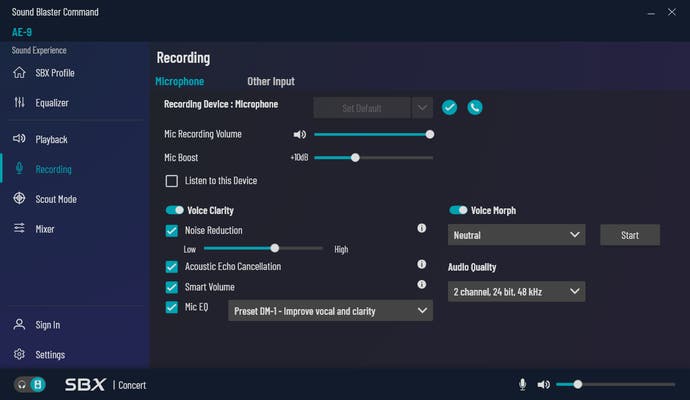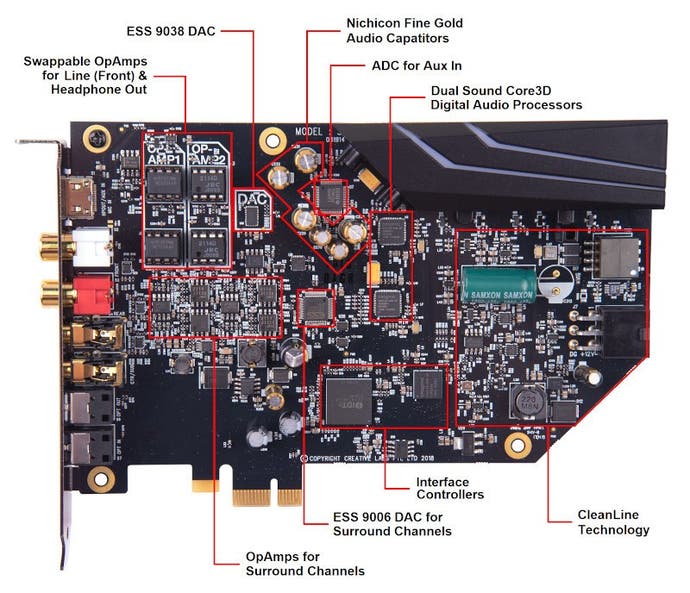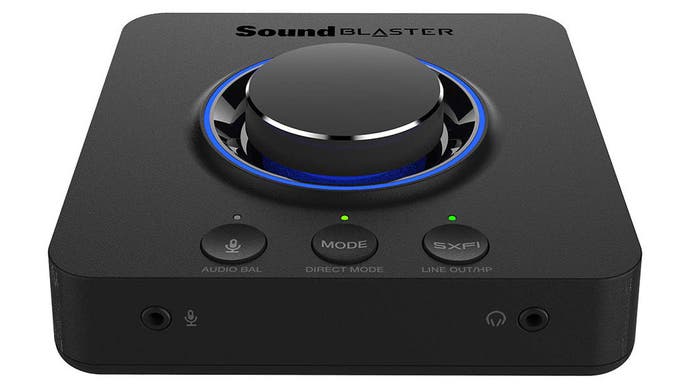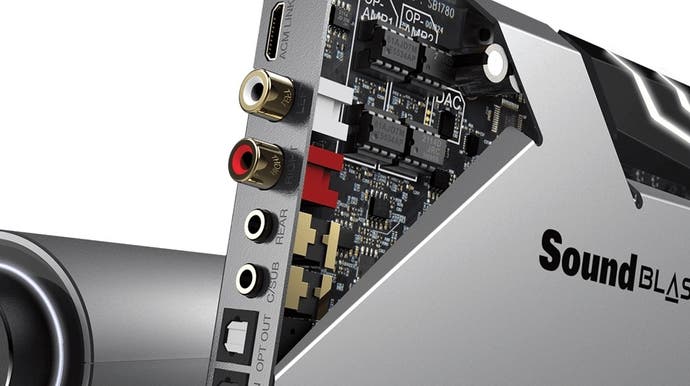Sound Blaster AE-9 review: do you really need a sound card in 2019?
Plus: thoughts on the Sound Blaster X3 external sound card.
Do you remember Sound Blaster? For a brief moment in time in the 90s, these sound cards were an essential upgrade for any gaming PC. They gave you a place to plug in your pre-USB joystick for bouts of X-Wing vs TIE Fighter, as well as substantially better audio quality than whatever was built into your PC - if you were lucky enough to have anything at all. Nowadays though, even basic motherboards include integrated audio hardware with perfectly fine quality, plenty of inputs and fancy software features - that you've probably never used. And of course, GPUs can pipe out digital surround sound over HDMI too. Surprisingly perhaps, new Sound Blaster cards are still in production today - and after testing Creative's new flagship model, the $350/£299 AE-9, I think discrete audio hardware is still worth considering today. Here's why.
First, high-end modern sound cards can actually replace a lot of other audio equipment. The AE-9 is a perfect example, as it comes with both a sound card that goes in your PC and an 'audio control module' or ACM that sits on your desk, joined by a mini HDMI cable (and a stern warning not to plug anything else into the mini HDMI port). The ACM serves as both a headphone amp and an audio interface, with room to plug in both ¼ inch and ⅛ inch headphones plus XLR, ¼ inch and ⅛ inch microphones (with optional +48V phantom power). You can also plug in auxiliary devices, like your smartphone or MP3 player, via phono inputs on the back of the box. Meanwhile, the sound card itself includes four line out ports (two phono, two ⅛ inch) plus optical in and out, allowing a full set of 5.1 surround-sound speakers to be connected. As well as the AE-9's built-in Acoustic Engine processing, you can also opt for Dolby Digital Live and DTS Connect Encoding - sadly, the more recent Dolby Atmos and DTS:X standards aren't supported, nor are 7.1 surround sound setups·
Update, December 20th 2019: We recently tested the Sound Blaster X3, a more affordable external sound card and headphone amp from Creative. Here's what we thought.
While audio interfaces like the FocusRite Scarlett often include more knobs to turn and switches to flip (there's only a volume wheel, a three-point impedance switch and a couple of extra buttons on the AE-9's ACM), there's enough here to handle most simple use cases - like hooking up a powered XLR condenser microphone for streaming, recording a musical instrument or keeping both headphones and speakers connected at all times. Having everything in one place, instead of split across multiple boxes, is convenient if a little messy.

If you don't have your speakers within easy reach or a volume wheel on your keyboard, you'll also appreciate being able to quickly and precisely adjust your playback volume as needed with the ACM's wheel. I found this particularly came in handy for 1v1 situations in Counter-Strike, where hearing a single errant footstep can mean the difference between glorious victory and an ignoble knife in the back. If an ambulance comes blazing past your flat while you're trying to clutch, for example, being able to boost the volume without losing focus is a god-send.
Speaking of footsteps, the AE-9 also includes a scout mode which boosts the volume of all sounds up to a certain threshold. In testing this mode for a few hours, I did notice it became easier to hear footsteps in quiet moments, but my internal reckoning of how far away these footsteps were was totally lost. I ultimately decided against using the mode, but it could be helpful for anyone that's hard of hearing in one or both ears or plays in a very noisy environment. The same goes for the specific game profiles found in the Sound Blaster Command software, which tend to add distracting effects rather than any compelling features. For single-player games, these might be alright, but for anything competitive I'd recommend sticking with a neutral reproduction.
You might also consider a high-end sound card like the AE-9 if you've noticed static or other interference on playback or recording. Despite modern improvements to motherboards and power supplies, cheap or poorly designed models can still introduce hisses, hums and other annoying noise. This is a little annoying when you're listening to music at low volumes, and even more so when you're actually trying to record a podcast or stream your gameplay. The AE-9 uses something Creative call CleanLine, which corrects for the power supply ripple caused by high-end GPUs and tries to ensure a perfectly clear input.

In my testing with a Blue Ember XLR condenser mic, I did notice a significantly cleaner sound than using my motherboard's built-in solution. There is also a host of software options to adjust the mic input further by cancelling out echoes, reducing noise and equalising the sound to adjust bass and treble. There's also a voice morph feature that allows you to sound like an orc, robot, dwarf or kid. These aren't much use for professional recording, but they can certainly liven up a boring round of Rainbow Six Siege.
Beyond adding new features, the AE-9 just sounds good. It's hard to put this into words as I'm not a dedicated audiophile, but both my Audioengine A5+ speakers and Sennheiser HD 598 headphones sounded brighter and more detailed than they did using integrated audio built into my X570 Aorus Master. Compared to the Cambridge Audio XS DAC I previously used with the headphones, it was a closer contest, but the AE-9 still came out on top.
This probably shouldn't be too surprising when you look at the sound card itself, which is home to a flagship-grade DAC - an ESS Sabre 9038 capable of 32-bit 384-kHz high-res audio - plus fine gold capacitors and even swappable op-amps that allow you to change the finer characteristics of the sound going to your speakers or headphones. The AE-9's bi-headphone amp is also powerful, capable of driving delicate 1 ohm IEMs or demanding full-size headsets with up to 600 ohms of impedance. At every level, Creative seem to have paid strict attention to the components and materials they're using - as you'd hope for a £300 sound card.

Despite nailing the execution in almost every area, there are still a few flaws with this product - and a few downsides to going with a sound card over your motherboard's integrated solution, a USB headset or HDMI out from your graphics card to a receiver. For the latter case, modern A/V receivers tend to offer more advanced surround sound formats including DTS:X and Dolby Atmos, which can't be matched by the AE-9 and its support for up to 5.1 surround sound.
Next is the requirement for a free PCIe slot in your motherboard and a six-pin PCIe power input. On most full-size desktops, this won't be an issue, but it may remove the AE-9 from contention from those with smaller ITX motherboards or powerful graphics cards using up their six-pin PCIe power cables. The actual power input on the AE-9 is also poorly designed, with so little clearance around the plug that the clip that secures the cable barely fit and I needed to use considerable force to insert and remove it.
The control module could also be easier to use. Adjusting the volume up and down with the wheel makes sense, as does muting by pressing in the wheel, but switching between headphones and speakers is clumsy - you need to press and hold for exactly two seconds, and it's very easy to underestimate the timing and end up switching off your sound at the exact point you wanted to hear it on the right audio device. The ACM also weighs very little, so you'll end up pushing it back on your desk unless you hold it in place with the other hand.
A software option to make the little-used SBX button - which toggles post-processing effects - into an input switch would go a long way to solving these annoyances. Unfortunately, it wouldn't help the other big issue with switching from speakers to headphones, which is that most web apps stop playing and must be reloaded. By comparison, swapping between different audio devices in Windows works seamlessly. Despite these complaints, none of these issues have tempted me to go back to my previous integrated audio for speakers and USB DAC for headphones setup.
So where does this leave us then? While entry-level sound cards are a thing of the past, high-end solutions like the AE-9 do just enough to justify their consideration. If you want a better audio listening experience for music and games, pick up a solid headphone amp/DAC and a good headset. If you want to get into the world of content creation, a good XLR or USB mic can help significantly. But if you want both top-notch sound quality and a wide range of recording options, the AE-9 is a clever all-in-one solution that justifies its premium price tag.
Sound Blaster X3

Update, December 20th 2019: We recently had the chance to test out the Sound Blaster X3, an external sound card and headphone amp/DAC that shares some features with the AE-9 such as high resolution audio support, a convenient volume knob and a range of sparkly equaliser modes. It also includes some unique features, such as SXFI, which uses photos of your ears and face to provide a better simulated surround sound mode. We didn't find SXFI that convincing in our testing, preferring simple stereo sound for its more accurate imaging, but we did appreciate the X3's flatter design and top-mounted volume wheel as these eliminated the ergonomic annoyances we had with the AE-9. There are still a great number of input options available, with separate 3.5mm inputs for headphones and mic up front, then five more 3.5mm ports and optical audio on the back. If you want a solid headphone amp and external sound card capable of driving even high-impedance headphones, the X3 is definitely worth a look at $120/£110.

